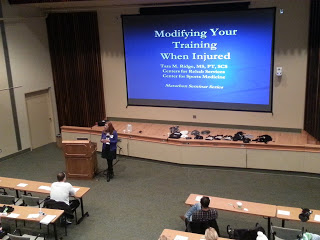Listen to your body. Heed its warnings.
There is still plenty of time to repair, recover or even miss weeks of training before embarking upon more miles of preparation for the Dick’s Sporting Goods Pittsburgh Marathon May 5, physical therapist Tara Ridge, M.S., P.T., told runners at UPMC Montefiore on Saturday.
“Persistent pain leads to altered mechanics,” Ridge told the Ladies Hospital Auxiliary Society Auditorium crowd in this second of three marathon seminars sponsored by UPMC Sports Medicine, where she oversees its physical-therapy residency program. “That’s what we want to prevent, the spread of those injuries over the musculoskeletal chain.”
Good pain – yes, there is such a thing – comes in the form of joint discomfort after a workout or stiffness that dissipates when you exercise or stretch properly. All are varieties that should go away within 24 hours.
Bad pain keeps you awake at night, worsens as you run or walk, alters how you stride or perform other mechanics. That is pain you cannot live or train with, so go see a sports-medicine specialist.
Ridge provided a wide array of tips about training while injured, and wanted the long-distance runners – many of them in their first or second marathon or half-marathon – to avoid four common training mistakes:
- Training Error No. 1: Persistent high-intensity training without lower-intensity workouts. In other words, you have to vary, such as cross-training. And sprinkle in days off.
- Training Error No. 2: Sudden increase in mileage and intensity without adequate rest. “Recovery time is crucial because the body has a repair process. Without the repair process, you build in inflammation,” Ridge said. Someone returning from an injury or time off should still limit his/her increase in mileage by 10 percent each week and alternate the workout’s intensity from easy to hard.
- Training Error No. 3: Single, severe training or competitive sessions. This isn’t a sprint, it’s a marathon after all. You’ve got a long way to go, so take it easy.
- Training Error No. 4: Repetition, repetition. This can be avoided simply if someone who trains on a track makes sure to reverse direction every other day. This can also be hard to break old habits. Four of five injuries come from overtraining, and once again modifications and cross-training come into play.
The simple rules for injuries: If it’s stiff, heat it up; if it’s joint pain, cool it down (or bring down the swelling) with ice. RICE – rest, ice, compression and elevation – remains the best acronym for regaining health. Ice compresses should last 20 minutes every two hours. For specific site tenderness and swelling, fill a paper cup with water, freeze it and use it as a cooling massage device.
Be careful, though. Don’t mask pain with ice and over-the-counter anti-inflammatories. If an injury or ache persists for two to three days and if alternating workouts and intensity plus changing exercises or equipment fails to pacify the pain, stop training and see a physician, Ridge advised.








